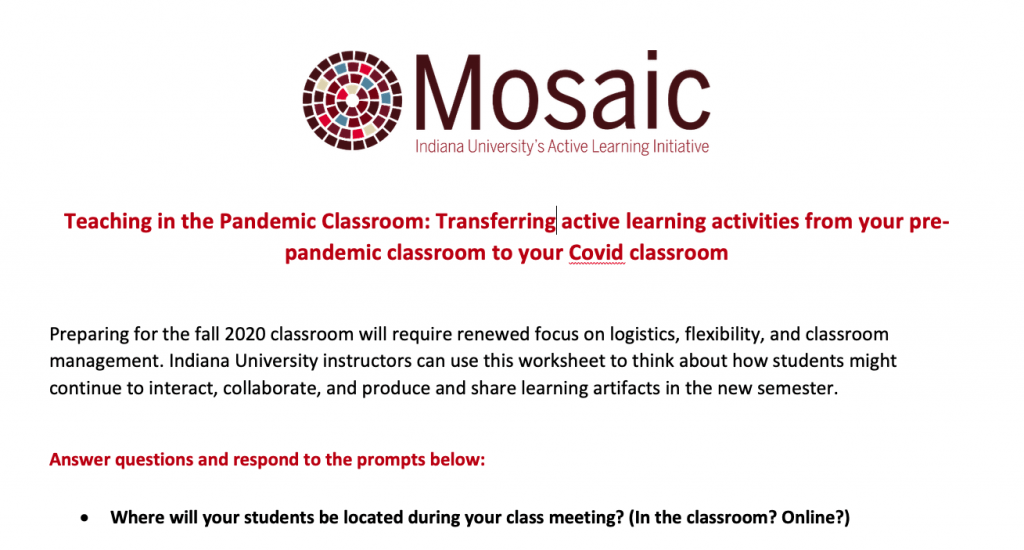Reconsidering support for fall
Since I began working for the Mosaic Initiative in 2015, I've focused on helping instructors develop and implement active learning approaches for any Indiana University classroom. In today's blog, I want to share reflective worksheets that I've used to direct and scaffold instructor thinking about the intersections of space and pedagogy in activity design. Then I want to share a revised version of those worksheets, newly amended, that I've re-envisioned to begin to address our fall 2020 circumstances.
Previous support: analyzing your spaces for active learning
To help instructors recognize how classroom space influences their approaches to student engagement, I've used this handout (Mosaic Active Learning Activity Planner Worksheets _ July 2020) to guide instructors in 1) thinking through activity design and classroom tools analysis and 2) identifying the connections between them. My primary goal for this approach has been to help faculty figure out how to transfer activities from one classroom to another (while making small adjustments for differences in classroom features) by encouraging them to:
- Analyze their physical classroom - Identify what tools are available and which you might use during the semester to facilitate your active learning approach.
- Analyze their activity - Identify learning outcomes, interactions, tools required, and learning artifacts
- Troubleshoot - Identify logistics considerations, classroom management issues, and possible workarounds
- Adjust - Identify small adjustments to activities to be able to implement in another classroom
Re-adjusted for fall 2020
Most often used in a faculty workshop scenario, these worksheets have successfully supported instructors in past semesters. However, considering our new, highly variable, circumstances for fall 2020, I've re-conceived my previous approach. As you can see, the new worksheets look a bit different: Mosaic Teaching in the Pandemic Classroom Worksheets _ July 2020
What's different?
I've asked instructors to identify where they and their students are located. Some instructors will find themselves with students both in the classroom and online. Having students in a classroom while others are online, whether or not the instructor is in the same classroom creates significant logistical changes that require consideration.
I've asked instructors to consider what a fully online version of their activity might look like. It's reasonable to imagine that universities might have to go online again at some point during the fall. So, I've added a step in the revised activity planner that asks instructors to consider a fully digital environment for their active learning approaches.
What's the same?
The core idea remains the same: identify the ways that your learning environment, tools, and ability to interact influences how successfully you implement active learning. Identify what new circumstances and challenges you might encounter. Then make small changes to your original plans to address your unique situation for the semester.
What's next?
At the end of the fall semester, I will revise the amended worksheets for the spring. Until then, instructors can download and use these handouts to help them think about teaching this fall.
Faculty developers can use the handouts as a starting point for developing their versions for their institutions, instructors, and unique fall circumstances. For example, the Center for Teaching and Learning at IUPUI has created its version: IUPUI_CTL_Enagaging Students in a Physically Distanced Classroom—Activity Planner 2020
How about you, faculty developers? What approaches, tools, or worksheets are you using to support your faculty this fall? What adjustments are you making to your efforts to help faculty approach active learning next semester?


